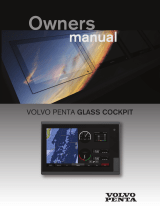
• Do not use excessive force when installing mounting screws.
Use only the amount of force needed to keep the sensor in
place.
• Apply force evenly between the mounting screws.
NMEA 2000 Connection Considerations
• This sensor connects to an existing NMEA 2000 network on
your boat.
• If the included NMEA 2000 drop cable is not long enough to
reach your NMEA 2000 network, a drop cable of up to 6 m
(20 ft.) can be used, according to the NMEA 2000 guidelines.
Item Description
À
Sensor
Á
NMEA 2000 power cable (existing; not included)
Â
Ignition or in-line switch (existing; not included)
Ã
12 Vdc power source
Ä
NMEA 2000 T-connector (included)
Å
NMEA 2000 terminator or backbone cable (existing; not included)
Calibration
After installation is complete, you must calibrate the heading
sensor for best results. Depending on the types of devices
connected to the NMEA 2000 network, you can calibrate the
sensor using either a menu-based method or a basic method.
When you connect the sensor to the same NMEA 2000 network
as a compatible Garmin chartplotter, you are prompted to begin
menu-based calibration when the chartplotter detects the new
sensor (Performing Menu-Based Calibration, page 2). Go to
www.garmin.com for a list of compatible chartplotters.
NOTE: A software update available in mid-2017 enables you to
perform menu-based calibration using a compatible chartplotter.
If your chartplotter has software that predates this update, you
must perform basic calibration.
If you connect the sensor to a NMEA 2000 network without a
compatible Garmin chartplotter, you must perform basic
calibration instead of menu-based calibration (Performing Basic
Calibration, page 2).
Performing Menu-Based Calibration
Before you can perform menu-based calibration, you must
connect the sensor to the same NMEA 2000 network as a
compatible Garmin chartplotter.
If the sensor has not been calibrated successfully, a message
appears each time you turn on a compatible Garmin chartplotter.
1
From the sensor calibration screen, select Compass Cal..
TIP: You can open the calibration page at any time by
selecting the device from Menu > Settings >
Communications > NMEA 2000 Devices.
2
Select Begin.
3
Follow the on-screen instructions until the compass
calibration is complete, taking care to keep the boat as
steady and level as possible.
The boat should not list during calibration.
If possible, you can turn the vessel in place by engaging two
engines in opposite directions.
When the compass calibration is complete, a value appears
near the Compass Cal. setting. A value near 100 indicates
the sensor was installed in a perfect magnetic environment
and calibrated correctly. If the heading performance is
unacceptable, and the value is closer to 0 than it is to 100,
you might need to relocate the sensor and calibrate the
compass again.
4
Select Auto Heading Alignment.
NOTE: Auto Heading Alignment is available only if there is a
GPS source connected to the NMEA 2000 network. If you do
not have a GPS source connected, you must perform the
Fine Heading Alignment instead (Adjusting the Fine Heading
Alignment, page 2).
5
Select Begin.
6
Follow the on-screen instructions until the alignment is
complete.
Adjusting the Fine Heading Alignment
If you do not have a GPS source connected to the NMEA 2000
network, Auto Heading Alignment is not available as part of
menu-based calibration, and you must adjust the Fine Heading
Alignment instead.
You can adjust the Fine Heading Alignment in conjunction with
Auto Heading Alignment to fine-tune the heading output
(optional).
1
From the sensor calibration screen, select Fine Heading
Alignment.
2
Using a landmark or a known good compass, determine the
heading of your boat.
3
Adjust the heading until it matches your measurement.
4
Select Done.
Performing Basic Calibration
If you connect the sensor to a NMEA 2000 network without a
compatible Garmin chartplotter, you must perform basic
calibration instead of menu-based calibration.
You must be able to view heading data from the sensor on a
connected chartplotter or marine display before you can perform
basic calibration. If you cannot view heading data on your
connected display, check the NMEA 2000 network and power
connections.
All other sources of heading data that are not based on GPS
must be removed from the NMEA 2000 network while
performing basic calibration.
When performing basic calibration, you first calibrate the
compass and then align the heading in one continuous
procedure. If you installed the sensor with the cable pointing
toward the bow, parallel to the keel, it may not be necessary to
align the heading.
NOTE: If you choose to align the heading, you must connect a
GPS source to the NMEA 2000 network. The boat must be able
to reach a cruising speed of at least 6.4 km/h (4 mph) to perform
the heading alignment.
1
Drive the boat to a location with calm, open water.
2
Set the display to view heading data from the connected
sensor.
3
Disconnect the sensor from the NMEA 2000 network or turn
off the power to the NMEA 2000 network.
4
Wait while the boat becomes level and stationary.
2




